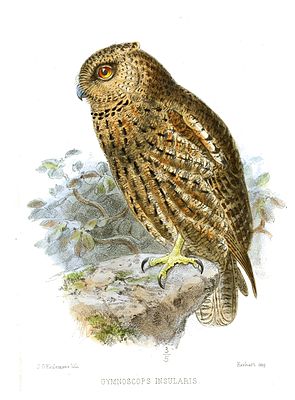Seychelles scops owl
| Seychelles scops owl | ||||||||||
|---|---|---|---|---|---|---|---|---|---|---|

Seychelles scops owl ( Otus insularis ) |
||||||||||
| Systematics | ||||||||||
|
||||||||||
| Scientific name | ||||||||||
| Otus insularis | ||||||||||
| ( Tristram , 1880) |
The Seychelles scops owl ( Otus insularis ), also known as the Seychelles eared owl, is a rare species of owl that is only found in Morne Seychellois National Park on the island of Mahé .
Description and nutrition
The Seychelles scops owl reaches a size of 19 to 22 cm. The wing length is 17 cm. Their plumage is red-brown and shows black shaft stripes. The underside and the face veil are reddish. The long, gray legs are feathered. The ears are very small. The eyes are large and golden yellow. Their call, which sounds like a sawing “waugh waugh” with different “tok tok” tones, can be heard from a long way off. It can be heard especially in the dark. Their diet consists of geckos, tree frogs and insects (e.g. grasshoppers).
Endangerment and existence
The original range of this bird, which was first described in 1880, was the Seychelles islands Mahé, Praslin and Silhouette . Due to the deforestation of the mountain forests and the introduction of strange animals such as rats, cats and barn owls, the population declined so drastically that the species was thought to be extinct in 1906. In 1959 it was rediscovered by the French naturalist Philippe Loustau-Lalanne in a mountain cloud forest above 200 m above sea level on Mahé. The first nest was found in 1999. The breeding success did not materialize, however. In 2000, an infrared camera took the first photos of a mother with a nestling. Since nothing was known about the population for a long time, the IUCN had classified this owl species in the category "critically endangered". With the discovery of further populations since 1996, it was found in 2002 that the population had stabilized at around 318 animals. Today the distribution area extends over 159 territories, which cover an area of 33 km². Thanks to this knowledge, this owl species was downgraded to the category "endangered" in 2004.
literature
- Bruce Campbell: The Great Bird Book. Eugen Ulmer Verlag, Stuttgart 1976, ISBN 3-8001-7025-6 .
- J. Del Hoyo, A. Elliot, J. Sargatal (Eds.): Handbook of the Birds of the World . Volume 5: Barn-Owls to Hummingbirds. Lynx Edicions, 1999, ISBN 84-87334-25-3 .
- Claus König, Friedhelm Weick: Owls of the World. 2nd Edition. Christopher Helm, London 2008, ISBN 978-0-7136-6548-2 .
Web links
- Otus insularis in the endangered Red List species the IUCN 2008. Posted by: BirdLife International, 2008. Accessed January 31 of 2009.
- Entry on Owlpages (English)
- D. Currie, AC Mateman, CM Lessells, R. Fanchette: Sexual size dimorphism in the critically endangered Seychelles Scops Owl Otus insularis. In: Ringing & Migration. 21, 2002, pp. 16-18. (PDF file; 434 kB; English)
- ARKive - Photos and information on Otus insularis